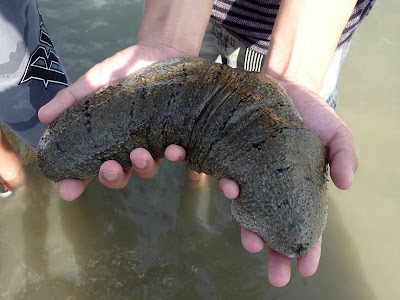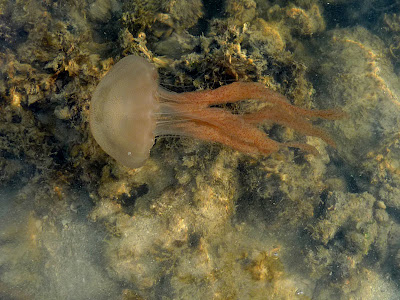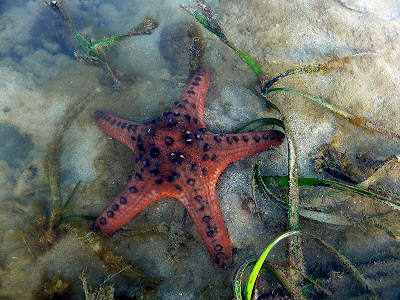Anyway, I was the hunter-seeker on Saturday and the guide for a group of enthusiastic students from Tampines Secondary on Sunday. Here's another quick look at some of the shots I managed to grab for the 2 walks.

We had to walk to the intertidal area again since it was rather early and the NEA staff hasn't arrived to drive us to there. This was my group from Tampines Secondary School. They were certainly a very jolly bunch of people, and even the long walk to the shore was made rather enjoyable :P

And here's the usual group photo I always got my groups to take while crossing the seagrass lagoon.

As per always, our visitors got all excited when they saw the sand-sifting sea stars (Archaster typicus).

I found 2 really long synaptid sea cucumbers (Family Synaptidae) on Saturday, and 3 of them on Sunday. The longest one was more than 2m long!

Another common sea cucumber found on Semakau - the stonefish sea cucumber (Actinopyga lecanora).

This sea cucumber, commonly called the sandfish sea cucumber (Holothuria scabra), is the species that's eaten by the Chinese. However, they must be processed to remove the toxins before they can be eaten.

Here's another sea cucumber which I often saw on our southern shores, but still don't know its ID. When we touch it gently, it immediately eject lots of sticky white threads to defend itself. When they encounter any predators, the sticky threads will stick to and confuse the latter. Update: Have found out that this is could be an impatient sea cucumber (Holothuria impatiens). 2nd Upate: Apologies for the confusion. This is not Holothuria impatiens. But a different species. More details to be published soon when we confirmed the ID.

A smooth and pretty ovum cowrie (Cypraea ovum) hiding among some rocks.

We found a cute upside-down jellyfish (Cassiopea sp.). This jellyfish has symbiotic algae, mostly in its tentacles, which photosynthesises better with it being upside-down since they will then be exposed to the sun. Some of the food made by the algae will be transferred to the jellyfish.

These pinkish orange jellyfish seemed to be in season too, and we had been seeing lots of them in local waters recently. Understand from CH that they sting very painfully if you accidentally touch them.

I found this interesting sea anemone on the leaf of a tape seagrass. The last time I found something similar was last October at Changi. According to sea anemone expert Dr Daphne at that time, this anemone is a member of the family Aliciidae, and these anemones supposedly can give anyone who touches them a nasty sting.

Not sure if it's just my imagination or what, but I do get the feeling that I'm seeing more such soft corals these days.

The highlight of any Semakau trips was always the knobbly sea star (Protoreaster nodosus).

And we found two of them on Saturday!

Here's the traditional group shot with the knobbly sea star.

And surprise surprise! On Saturday, I found a cushion star (Culcita novaeguineae). The last time we found one at Semakau was in March 2007! This cute sea star supposedly feed on corals though :P

All the students from Tampines Secondary School who joined the walk on Sunday managed to squeeze into the shelter at the southern most point of Semakau for a group shot.
While it was a really hot and sunny weekend, I was glad that everyone still managed to have a lot of fun! :)

No comments:
Post a Comment